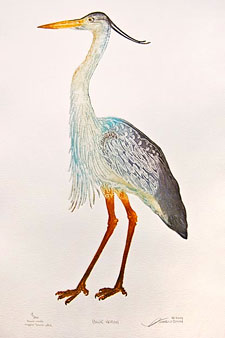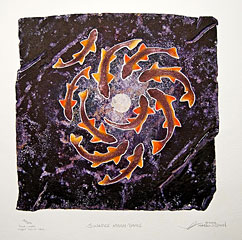Quincy Pond Print Works: Past Lives Brought into Focus
 Matthew Smith, Blue Heron 2009. Copper block etching.
Matthew Smith, Blue Heron 2009. Copper block etching. Photograph courtesy of Matthew Smith
Artists wrestle with ideas and inspirations, inanimate challenges and setbacks. But for artist, inventor and entrepreneur Matthew Smith, he's learned to trust his instincts. And, after living a few past lives as a fishermen and a wrestler, those instincts led him right to copper art.
At age 22 with an associate's degree in fisheries management from University of Rhode Island, he was charged as captain of an 80-foot trawler out of Newport, R.I. Today, he makes handmade copper block and intaglio etchings of marine life, fish, turtles, and other creatures of the sea. His time at sea helped him learn to make quick decisions, which is especially needed in printmaking.
"You had to be able to live for tomorrow as a fisherman," says Smith from his Copper Canoe Gallery in Exeter, N.H. . "You had to know where the fish were going to move the next day."
And, although he had many successful tomorrows as a commercial fisherman, even earning the title as best commercial fishing boat captain in the Northeast, he was overcome by realization that the industry had become too destructive.
So he hand-built a handsome log home (his studio to this day) that skirts peaceful Quincy Pond in Nottingham, N.H., and abandoned fishing at sea to hunt down his lost love in art - one he inherited from his mother, an accomplished painter. He took printmaking classes at University of New Hampshire and Newport Museum School, but then pioneered his own path toward a tribute in copper to the sea creatures he once hunted. Smith then opened Quincy Pond Print Works to help him create his prints, frame them to museum standards, and make them available to collectors in New England and across the country, shipped in packages he designed himself.
 Matthew Smith, Sunapee Moon-dance 2009. Copper Block Etching & Lead Plate.
Matthew Smith, Sunapee Moon-dance 2009. Copper Block Etching & Lead Plate. Photograph courtesy of Matthew Smith
The centuries-old craft of copper block etching, or Italian-born "intaglio," a printmaking art that blends acid into copper plates for scenes that are then pressed onto hand-molded Italian paper, was reinvented by Smith. Sheets of copper are cut into plates with precision band saws and etched for the purpose of acidic reactions.
"Copper will work with you in these chemical reactions," says Smith. "And there's more of an historic conversation with copper. Copper has a way of educating us … once we give up the struggle of making it do what we want."
Smith files down the edges by hand and creates a topography, a texture, of sea creatures and nature's sea beauty with a buffering compound perfect for creating on paper schoolies or octopi. Several copper plates (up to nine) may be needed per print; thousands have been sculpted by Smith to this day. It could take a day up to 18 days (for a copper lobster print, for example).
Once inks are chosen and prints are printed, no square inch of copper plate goes to waste. "Thousands of plates have been created, but nothing goes to waste," says Smith. "Starfish are reused into smaller starfish."
Smith says, after a staff and economy change, after seven lucky years, The Copper Canoe will be closing, but rerouting - into another challenge to be conquered by Smith - to his more online presence at quincypondprintworks.com and a cross-country wholesale sales movement by some members of his staff.
Resources:
Also in this Issue:
- Lower East Side Printshop: Working Side by Side with the Artist Community
- Evan Summer: The Fine Art of Intaglio
- Quincy Pond Print Works: Past Lives Brought into Focus
- New Show at Washington Printmakers Gallery Features Work by the New York Society of Etchers
- This History of Intaglio
